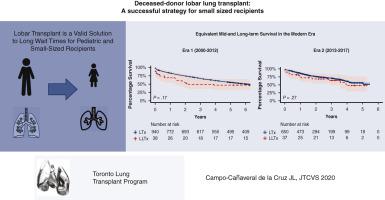The Journal of Thoracic and Cardiovascular Surgery ( IF 6 ) Pub Date : 2020-05-23 , DOI: 10.1016/j.jtcvs.2020.04.166 Jose Luis Campo-Canaveral De La Cruz 1 , Ben Dunne 1 , Philippe Lemaitre 1 , Mindaugas Rackauskas 1 , Jiri Pozniak 1 , Yui Watanabe 1 , Andrea Mariscal 1 , Jonathan Yeung 1 , Kazuhiro Yasufuku 1 , Andrew Pierre 1 , Marc de Perrot 1 , Thomas K Waddell 1 , Marcelo Cypel 1 , Shaf Keshavjee 1 , Laura Donahoe 1

|
Objectives
Lobar lung transplantation (LLTx) from deceased donors is a potential solution for donor–recipient size mismatch for small sized recipients. We reviewed our institutional experience to compare outcomes after LLTx to standard lung transplantation (LTx).
Methods
We retrospectively reviewed transplants in our institution from January 2000 to December 2017. LLTx early- and long-term outcomes were compared with LTx. Additional analysis of outcomes was performed after dividing the cohort into 2 eras (era 1, 2000-2012; era 2, 2013-2017).
Results
Among the entire cohort (1665), 75 were LLTx (4.5%). Compared with LTx, LLTx were more frequently bridged to transplant with extracorporeal life support or mechanical ventilation and were transplanted in a rapidly deteriorating status (respectively, 20% vs 4.4%, P = .001; 22.7% vs 7.9, P < .001; and 41.3% vs 26.5%, P = .013). LLTx had longer intensive care unit and hospital lengths of stay (respectively, median 17 vs 4 days, and 45 vs 23, both P < .001), and greater 30-day mortality (13.3% vs 4.3%, P = .001) and 90-day mortality (17.3% vs 7.2%, P = .003). In era 2, despite a significantly greater 30-day mortality (10.8% vs 2.8%, P = .026), there was no significant difference in 90-day mortality between LLTx and LTx (13.5% vs 5.1%, P = .070). Overall survival at 1, 3, and 5 years was not significantly different between LLTx and LTx (73.2% vs 84.4%, 56.9% vs 68.4% and 50.4% vs 55.8, P = .088).
Conclusions
Although LLTx is a high-risk procedure, both mid- and long-term survival are comparable with LTx in all cohorts in the modern era. LLTx therefore represents a valuable surgical option for small-sized recipients.
中文翻译:

死者大叶肺移植:小型接受者的成功策略
目标
死者的肺叶移植(LLTx)是潜在的解决方案,可以解决小规模受者的供者-接收者大小不匹配的问题。我们回顾了我们的机构经验,以比较LLTx与标准肺移植(LTx)后的结局。
方法
我们回顾性研究了我们机构从2000年1月至2017年12月的移植情况。将LLTx的早期和长期结局与LTx进行了比较。将队列分为2个时代(2000年至2012年第1时代; 2013-2017年第2年),对结局进行了进一步分析。
结果
在整个队列(1665年)中,有75个是LLTx(4.5%)。与LTx相比,LLTx更常通过体外生命支持或机械通气桥接到移植,并且以迅速恶化的状态进行移植(分别为20%vs 4.4%,P = .001; 22.7%vs 7.9,P <.001;分别为41.3%和26.5%,P = .013)。LLTx重症监护病房和医院的住院时间更长(分别为中位数17天vs 4天,中位数45 vs 23岁,均P <.001)和30天死亡率更高(13.3%vs 4.3%,P = .001)和90天死亡率(17.3%对7.2%,P = 0.003)。在第2代,尽管30天死亡率显着提高(P分别为10.8%和2.8%, = .026),LLTx和LTx在90天死亡率方面没有显着差异(13.5%对5.1%,P = .070)。LLTx和LTx在1年,3年和5年时的总生存率无显着差异(73.2%对84.4%,56.9%对68.4%和50.4%对55.8,P = .088)。
结论
尽管LLTx是高风险的手术,但在现代的所有队列中,中期和长期生存都可与LTx相提并论。因此,LLTx代表了小型接受者的宝贵手术选择。



























 京公网安备 11010802027423号
京公网安备 11010802027423号